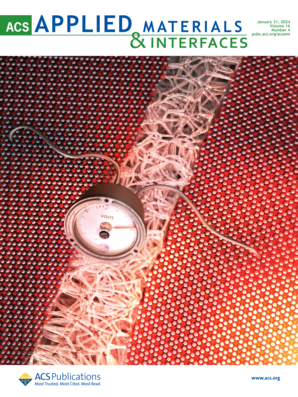皂素没食子酸盐负载掺杂钆的锌镓层状双氢氧化物(Zn/Ga@Gd-LDH)纳米载体用于减轻 NF-κB 介导的炎症反应
IF 8.3
2区 材料科学
Q1 MATERIALS SCIENCE, MULTIDISCIPLINARY
引用次数: 0
摘要
本工作描述了一种基于没食子酸皂苷(SG)治疗抗炎功效的药物传递系统(DDS),没食子酸和皂苷的组合,通过酯键化学偶联。该配方被装载到生物相容性掺钆锌镓层状双氢氧化物(Zn/Ga@Gd-LDH)纳米载体上。采用FT-IR、XRD、SEM和HPLC对合成材料进行表征。利用紫外可见光谱研究了最佳温度(45°C)和pH(5)下SG-Zn/Ga@Gd-LDH纳米颗粒的药物释放动力学行为。SG-Zn/Ga@Gd-LDH纳米颗粒的动力学释放行为表明,一级动力学模型最适合于释放谱。回归值(R2)为0.96614,表明在54 h内,载药纳米载体具有最佳的控释效果和最小的不良反应。体外和体内模型证实载药纳米载体具有抗氧化、抗炎和抗癌特性。Western blotting分析表明,SG-Zn/Ga@Gd-LDH通过阻断促炎蛋白p-p65的磷酸化和降低参与NF-κB通路的CRP水平来消除抗炎特性。SG-Zn/Ga@Gd-LDH通过减少促炎细胞因子的分泌而具有抗炎作用。SG-Zn/Ga@Gd-LDH对急性ccl4肝损伤模型的组织学参数研究显示抗炎作用。用99mTc对药物没食子酸皂苷进行放射性标记,测定其体内生物分布。色谱结果表明,放射性标记率可达90%。Wistar大鼠的SPECT-CT成像和离体伽马计数显示纳米颗粒的不同清除率,有助于评估药物递送纳米系统。所设计的体系还显示出抗氧化潜力,因为SG化合物具有IC50 127.45 μg/mL自由基清除活性。Ga@Gd-LDH对活细胞对乳腺癌MCF-7细胞的抑瘤能力为79.89±3.91%。因此,开发的配方可能是对抗炎症性疾病的有利策略。本文章由计算机程序翻译,如有差异,请以英文原文为准。

Saponin Gallate-Loaded Gd-Doped Zinc–Gallium Layered Double Hydroxides (Zn/Ga@Gd-LDH) Nanocarrier for Attenuating NF-κB-Mediated Inflammation
This work describes a drug delivery system (DDS) based on the therapeutic anti-inflammatory efficacy of saponin gallate (SG), a combination of gallic acid and saponin, chemically conjugated via an ester linkage. This formulation was loaded onto a biocompatible gadolinium-doped zinc–gallium-layered double hydroxide (Zn/Ga@Gd-LDH) nanocarrier. FT-IR, XRD, SEM, and HPLC were used to characterize the synthesized materials. UV–visible spectroscopy was employed to investigate the drug release from SG-Zn/Ga@Gd-LDH at an optimized temperature (45 °C) and pH (5). The kinetic release behavior of SG-Zn/Ga@Gd-LDH nanoparticles suggested that the first-order kinetic model was the most appropriate for the release profile. The regression value (R2) of 0.96614 indicated an optimal and controlled release for therapeutic effectiveness and minimal adverse effects over 54 h. The in vitro and in vivo models confirmed that drug-loaded nanocarriers exhibited antioxidant, anti-inflammatory, and anticancer properties. Western blotting analysis suggested that SG-Zn/Ga@Gd-LDH abrogates the anti-inflammatory properties by halting the phosphorylation of pro-inflammatory proteins p-p65 and decreasing CRP levels involved in the NF-κB pathway. SG-Zn/Ga@Gd-LDH exhibited an anti-inflammatory effect by reducing the secretion of proinflammatory cytokines. SG-Zn/Ga@Gd-LDH treatment against an acute CCl4-induced liver injury model showed anti-inflammatory potential in histological parameters’ study. Radiolabeling of the drug saponin gallate with 99mTc was carried out to determine its in vivo biodistribution. The chromatographic results indicated promising radiolabeling of up to 90% percentages. SPECT-CT imaging and ex vivo gamma counting in Wistar rats revealed different clearance rates of nanoparticles, aiding in the evaluation of the drug delivery nanosystem. The designed system also demonstrated antioxidant potential due to the SG compound having IC50 127.45 μg/mL free radical scavenging activity. Ga@Gd-LDH showed a tumor-suppressing ability of 79.89 ± 3.91% for viable cells against breast cancer MCF-7 cells. The developed formulation could thus be a conducive strategy against inflammatory diseases.
求助全文
通过发布文献求助,成功后即可免费获取论文全文。
去求助
来源期刊

ACS Applied Materials & Interfaces
工程技术-材料科学:综合
CiteScore
16.00
自引率
6.30%
发文量
4978
审稿时长
1.8 months
期刊介绍:
ACS Applied Materials & Interfaces is a leading interdisciplinary journal that brings together chemists, engineers, physicists, and biologists to explore the development and utilization of newly-discovered materials and interfacial processes for specific applications. Our journal has experienced remarkable growth since its establishment in 2009, both in terms of the number of articles published and the impact of the research showcased. We are proud to foster a truly global community, with the majority of published articles originating from outside the United States, reflecting the rapid growth of applied research worldwide.
 求助内容:
求助内容: 应助结果提醒方式:
应助结果提醒方式:


